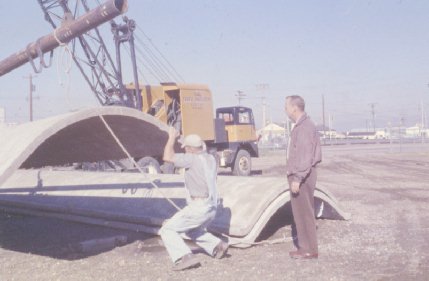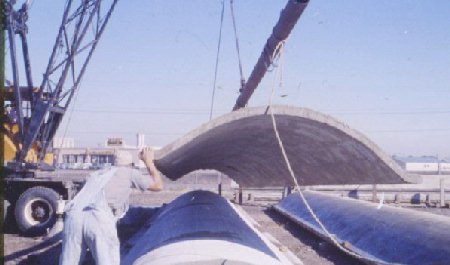|
The next picture shows the construction of precast barrel shells. They were first used for the cover of a water collection canal in the mountains of Colorado, but later were used in a number of industrial and residential buildings. As many as six shells were made from one form by casting the next shell on the previous one. To acccomplish ths, all of the vertical dimensions must be the same.

Click on image to enlarge.
This picture shows the precast barrel shells being placed in the mountains of Colorado. They were fabricated in Denver and shipped by truck. The supports for the shells are cast in place circles. They will carry the end forces of the shells if there is adequate reinforcing in the shell over the support.

Click onimage to enlarge
Next is a folded plate for a high school gymnasium. This design is the result of the experience accumulated for a number of previous designs.
Click to enlarge image
- The slab elements are thicker at the valleys and ridges, making it possible to use longer spans with the same minimum thickness. In this case over 20 feet. This, in turn, makes it possible to use less slope on the slabs, resulting in easier construction. When I wrote my program for folded plate analysis, I was motivated to include this feature of variable slab thickness.
-
The normal practice for edge member slab elements was to make them as much as one third of the width of the other slabs. Even this wide, the stiffness of the edge elements is much less, resulting in excessive deflection. In this case, the edge slabs are small and the edges are supported by steel columns embedded in the brick walls.
Shell structures need not involve projects with large areas or be of momumental design. The next picture shows a small shopping unit with a folded plate roof having a small span. Note, again, that the edge valleys have been supported by steel columns that will be embedded in walls. The roof was formed with fixed in place forms, but the shores were constructed so that they could remain in place while the other forms were moved quickly and still have the concrete supported agianst deflection.

Clixk on image to enlarge
The Ideal Cement Company needed a hangar to house a company plane, so it built a structure that would use one of it's products, light weight concrete. The building is a barrel shell, triangular in plan. The rear is supported by a number of columns and the front, which must have a clear span, by an arch bent in the middle. The thrusts from this bent arch at the high point, are carried by prestressing cables to a similar rib in the back wall. There are, of course, doors to cover the opening.

Click on image to enlarge
|